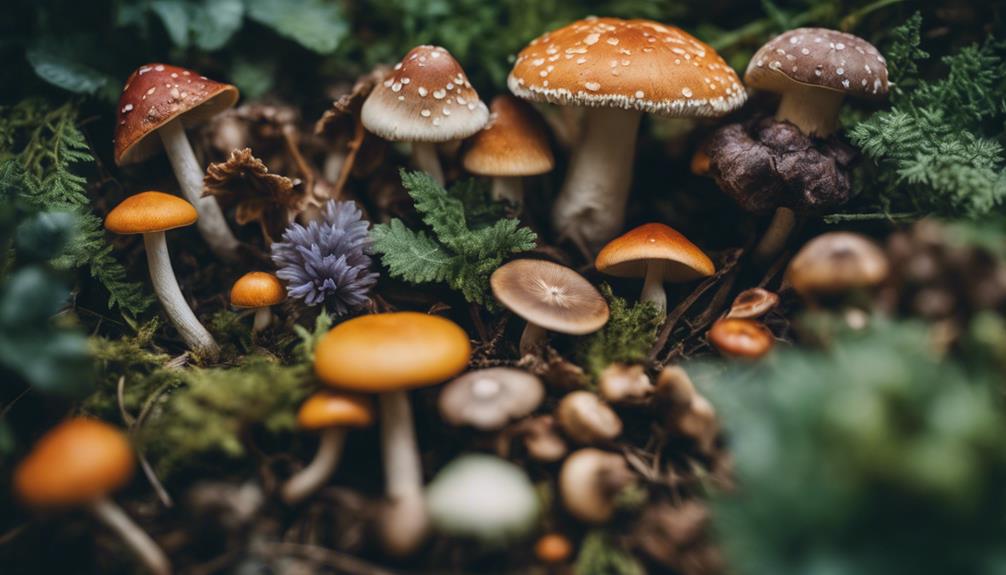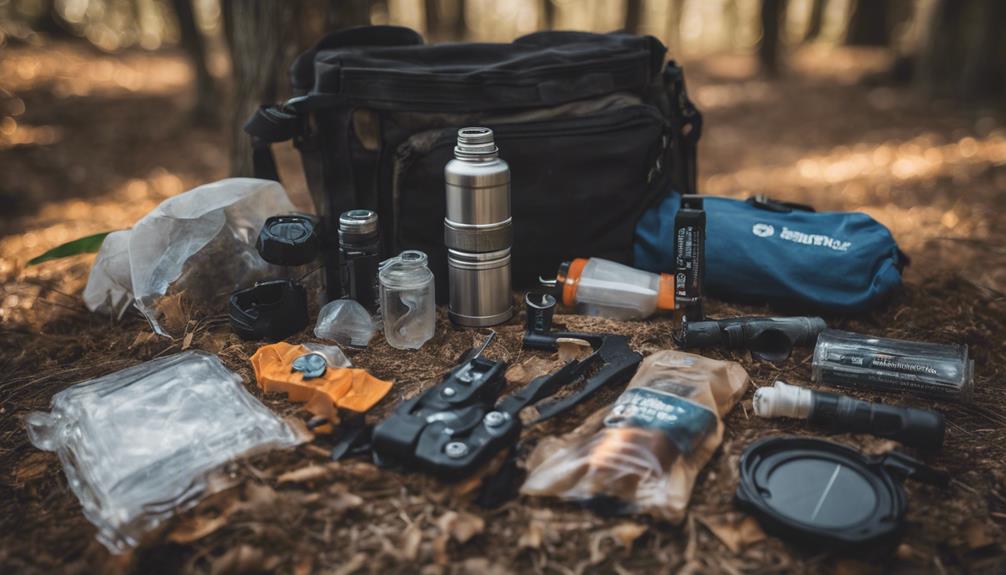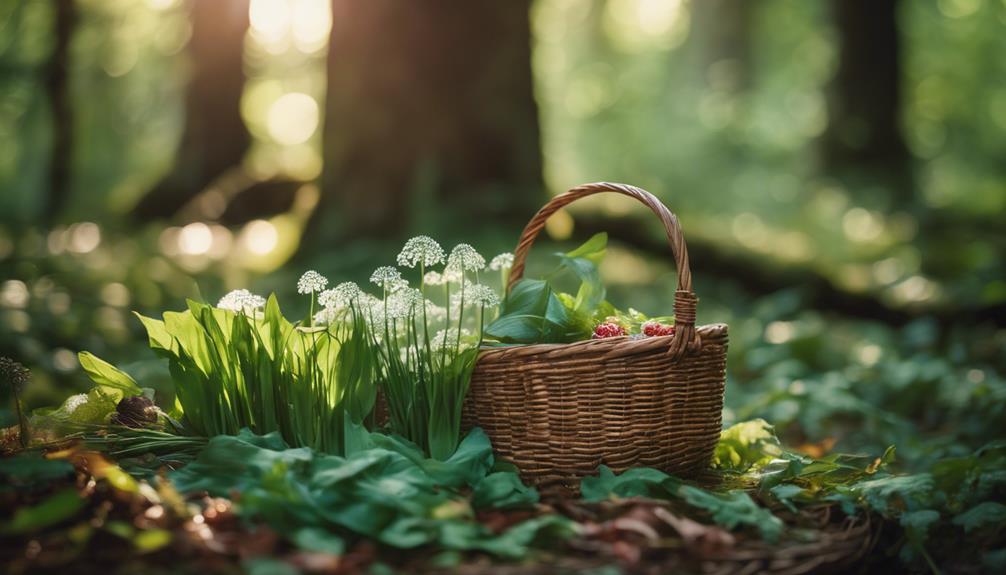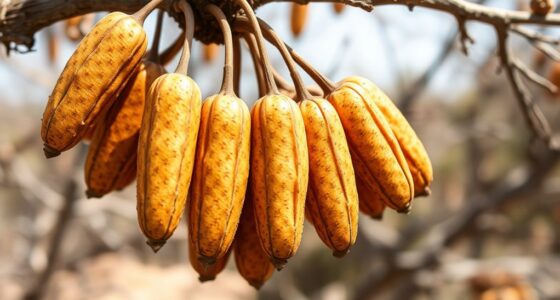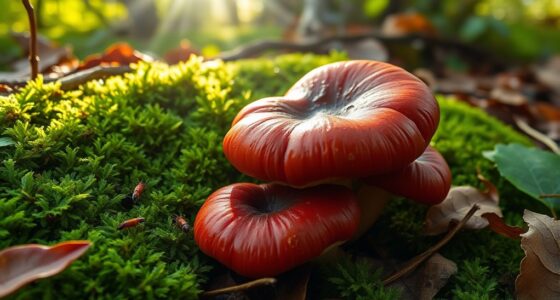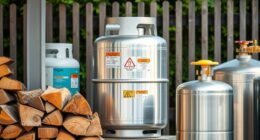Before tasting any wild plants, make sure you can accurately tell the safe ones from the harmful. Learn about local flora, the difference between edible and toxic plants, and always cross-check your findings. Start with easy-to-spot options like dandelions and wild berries. Remember, safety first! *Discover the excitement of foraging while staying safe.*
Key Takeaways
- Safety is paramount; identify plants accurately to avoid toxic species.
- Consult reliable sources like field guides and experts for plant verification.
- Start with easily recognizable plants before progressing to more complex species.
- Utilize all senses for plant identification and cross-reference multiple resources.
- Practice responsible foraging by respecting wildlife, ecosystems, and local regulations.
Foraging Basics
When foraging, safety is of utmost importance to guarantee accurate plant identification and avoid contaminated areas. Before venturing out to harvest wild edible plants, it's vital to familiarize yourself with the flora in your area. Look for resources or take a class to learn how to distinguish between edible plants and toxic ones. Always cross-reference multiple sources to maintain accuracy in your foraging endeavors.
Wild edible plants offer a variety of flavors and nutrients, but it's important to be cautious. Start by focusing on easily identifiable plants like dandelions, violets, or wild berries. These are great options for beginners and can add a tasty touch to your meals. Remember to harvest sustainably, only taking what you need and leaving enough behind for wildlife and future growth.
Safety Guidelines

When foraging, it's essential to distinguish between edible and toxic plants to avoid potential harm. Proper identification techniques, including using your senses, are necessary for a safe foraging experience.
Understanding common foraging risks will help you navigate the natural world with caution and confidence.
Edible Vs. Toxic Plants
Identify edible plants by looking for familiar characteristics like leaves, fruits, or flowers, while recognizing toxic plants through distinct features such as thorns, milky sap, or foul odor. When foraging, understanding these differences is essential for your safety. To help you distinguish between edible wild plants and toxic look-alikes, refer to the table below:
| Edible Wild Plants | Toxic Plants |
|---|---|
| Dandelions | Water Hemlock |
| Berries | Deadly Nightshade |
| Wild Garlic | Jimson Weed |
| Nettles | Poison Ivy |
Proper Identification Techniques
Utilizing field guides, apps, and expert advice is crucial for accurately identifying plants while foraging safely.
Before venturing out, equip yourself with a reliable field guide or a reputable foraging app to aid in plant recognition. These resources offer detailed descriptions, images, and sometimes even interactive features to assist you in distinguishing between edible and toxic plants.
If you're uncertain about a particular species, don't hesitate to seek guidance from experienced foragers or local botanists to guarantee accurate plant identification.
Common Foraging Risks
To guarantee your safety while foraging, understanding common risks and following safety guidelines is essential. When foraging, always be cautious about the plants you gather. It's important to positively identify them before consuming to avoid accidental poisoning. Poisonous look-alikes can be tricky, so educate yourself on how to distinguish between them and the ones safe to eat.
Additionally, be wary of contaminated areas and polluted environments. Understanding the risks associated with these areas is crucial for safe foraging practices. Using proper tools and clothing can also help minimize the spread of seeds, disease, or toxins.
Respect wildlife and ecosystems by foraging responsibly to maintain a sustainable environment for future foragers. By being aware of these common foraging risks and following safety guidelines, you can enjoy the benefits of foraging while staying safe and healthy.
Plant Identification Tips

Observe plants closely and engage all your senses when trying to differentiate between species. To identify edible plants accurately, look at their color, shape, texture, smell, and taste (if safe).
Study leaf patterns, growth habits, and unique features to spot distinct characteristics. If you're unsure, compare your findings with field guides or apps to confirm the plant's identity.
Be cautious of poisonous look-alikes by researching toxic plants that resemble the one you're trying to identify. When in doubt, seek guidance from local experts like experienced foragers, botanists, or nature centers.
Consulting with these professionals can help you make informed decisions about the plants you encounter. Remember, accurate plant identification is vital for safe foraging practices, so take your time to observe and research before consuming any wild vegetation.
Harvesting Techniques

When harvesting, remember to use sharp tools like scissors or knives to avoid damaging plants.
It's best to gather leaves and stems early in the morning when they're at their freshest.
Cutting plants at the base helps them regrow and sustains the foraging area for future visits.
Plant Identification Tips
For successful plant identification during foraging, rely on your senses and observation skills to distinguish between edible and toxic plants. Use your sense of smell, touch, and sight to positively identify edible plants.
Look closely at features like leaf shape, color, texture, and growth patterns to differentiate between what's safe to eat and what's harmful. It's important to study field guides, online resources, and apps for accurate plant identification before harvesting any wild plants.
Familiarize yourself with common edible plants in your region to enhance your foraging experience and guarantee safe consumption. By practicing responsible harvesting techniques, you'll only collect plants you can positively identify. Remember to leave no trace in the environment to maintain the delicate balance of nature.
Developing your plant identification skills won't only protect you from consuming toxic plants but also enrich your foraging adventures with a variety of delicious and safe edibles.
Ethical Foraging Practices
It's essential to practice sustainable harvesting techniques to secure the long-term health of wild plant populations while foraging responsibly. By following ethical foraging practices, you can help preserve the delicate balance of nature.
Avoid over-harvesting by taking only what you need, allowing plants to reproduce and flourish. Remember to respect private property and designated foraging areas to maintain positive relationships with landowners and protect natural habitats.
When harvesting, take only the edible parts of plants and leave no trace behind to minimize your environmental impact. It's vital to educate yourself on local regulations and guidelines for foraging, ensuring you're in compliance with ethical practices.
These guidelines help protect plant populations and ecosystems, ensuring they remain healthy and diverse for future generations. By following sustainable harvesting techniques and being mindful of ethical foraging practices, you can enjoy the bounty of nature while preserving it for years to come.
Nutritious Edibles

Explore the world of foraging to uncover a variety of nutritious edibles that can enrich your diet and provide essential vitamins and minerals.
Wild foods offer a diverse array of options for those looking to add nutrient-rich ingredients to their meals. Wild berries, such as blackberries and raspberries, are bursting with antioxidants and vitamin C, boosting your immune system and overall health.
Wild edibles like dandelion leaves aren't just weeds but are packed with essential vitamins A, C, and K, as well as minerals like iron and calcium. Nettles, another common find while foraging, are a great source of iron, magnesium, and vitamins A and C.
Don't overlook wild garlic, abundant in wooded areas, which not only adds flavor to dishes but also provides a good dose of vitamin C and antibacterial properties.
If you come across mushrooms like morels or chanterelles, remember that they aren't only delicious but also rich in protein, fiber, and various vitamins and minerals. Incorporating these edible species into your diet can introduce a whole new world of nutrition and flavors.
Seasonal Foraging

Discover the art of seasonal foraging by identifying and harvesting wild edible plants based on their availability during specific times of the year. Seasonal foraging is the practice of gathering plants that grow wild, which are both edible and often have medicinal properties.
Each season offers a unique selection of plants for foragers to explore and enjoy. During spring, you can find fresh greens like dandelions and ramps, perfect for salads or stir-fries. As the weather warms, spring foraging edible plants also include wild asparagus and stinging nettles, both of which offer a delicious addition to various dishes. Foragers should take care to properly identify and harvest these plants to ensure sustainability and safety. With the abundance of spring foraging edible plants available, it’s the perfect time to experiment with nature’s offerings in your kitchen. As the season progresses, more spring edible plants like fiddlehead ferns and morel mushrooms begin to emerge, adding variety to your foraging basket. These ingredients not only bring unique flavors to your meals but also offer a connection to the natural environment around you. Always be mindful of local guidelines to ensure that the delicate ecosystems supporting these spring edible plants remain protected for future generations.
Summer brings an abundance of berries and herbs such as mint and plantain, great for desserts or infusions. As fall approaches, nuts, seeds, and roots like acorns and burdock become available for harvesting.
Winter may seem sparse, but evergreen needles and bark can still be foraged for their unique flavors and potential health benefits. Understanding the seasonal availability of these plants won't only enrich your foraging experience but also help you plan your harvests and meals accordingly.
Family Foraging Fun

Engage in family foraging fun to bond with nature and introduce children to nutritious wild edibles. Family foraging not only strengthens your connection with the environment but also provides a fantastic learning opportunity for kids. When venturing out, remember the significance of adult supervision, accurate plant identification, and avoiding polluted areas for a safe and enjoyable experience.
Children of all ages can join in on the family foraging adventure, with early exposure enhancing their plant identification skills. Before heading out, make sure you have all the necessary supplies like adult supervision, a journal, water, a field guide, and appropriate harvesting tools.
After gathering your wild edibles, focus on proper storage, labeling, washing, preventing molding, and consuming freshly harvested plants for the best taste and nutritional value.
Frequently Asked Questions
What Is the Golden Rule of Foraging?
When foraging, always remember the golden rule: positively identify plants before touching or consuming them to avoid harm. Use all your senses, watch out for poisonous look-alikes, and steer clear of contaminated areas for a safe experience.
How Do Beginners Do Forage?
Want to start foraging? Begin by attending classes, learning from experts, and using online resources. Carry ID books, equip with gear, and explore habitats. Understand seasons, cooking, and preservation for a rewarding foraging experience.
What Is the Number One Rule of Foraging?
Identifying plants correctly is essential for safe foraging. Always positively identify plants before touching or eating. Avoid accidental ingestion of toxic species by following this rule. It guarantees a positive and safe foraging experience.
What Not to Eat When Foraging?
When foraging, avoid consuming any plant if unsure of its identification. Stay away from plants near contaminated areas. Do not eat bitter or soapy-tasting plants. Be cautious with wild mushrooms. Always verify before eating.
Conclusion
To sum up, foraging can be a rewarding and sustainable way to connect with nature and discover new flavors. Remember to always follow safety guidelines, properly identify plants, and use responsible harvesting techniques.
By learning about nutritious edibles and seasonal foraging options, you can confidently explore the world of wild foods.
So next time you're out in nature, take a closer look and ask yourself, 'Can I eat this?' Happy foraging!

